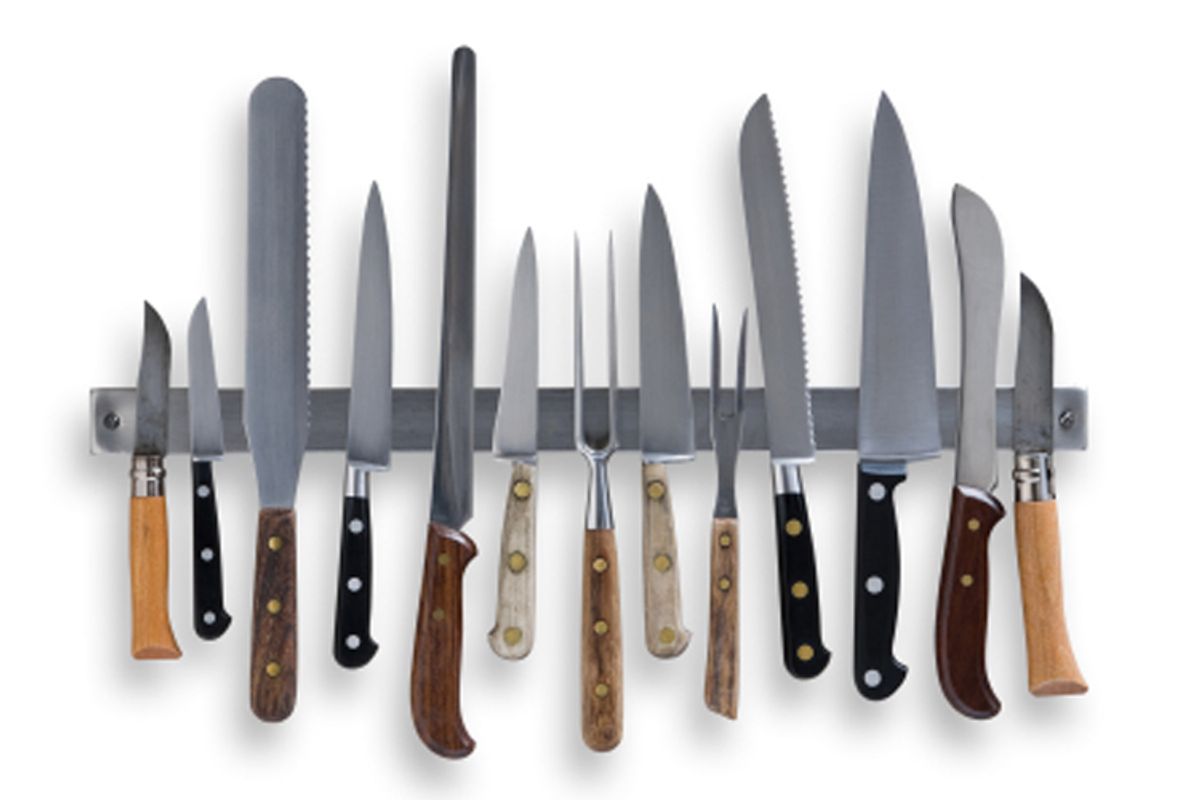If you were going to have any kitchen tool beyond a hot plate, a pot, and a spoon, it would be a really sharp knife. A dull knife crushes and tears rather than slices. It requires more strength, and if it takes real force it may slip dangerously. A blunt edge doesn't cut crisp vegetables so much as wedge them apart; it mashes tomatoes; it presses out juices from meat. You can test the sharpness of a knife by pulling your thumb across the blade at a right angle to it and without pressure. A dull edge feels smooth; a sharp edge catches at your skin.
Almost all the knives I use, above all the ten-inch chef's knife I use most often, are forged -- hammered -- from a single piece of hot steel. Forged knives are typically more three-dimensional than the other, dominant kind, which is stamped out of a thin rolled sheet. But a forged knife doesn't cut automatically better than a good stamped knife. (An excellent one is the Forschner Victorinox ten-inch chef's knife, sold online for as little as $21, one of the great knife bargains.) And even the cheapest knife can be made extremely sharp. The knives at a low-price chain store are all stainless-steel, like nearly every knife today, but the metal is nearly always thin, most of the cutting edges are coarsely ground and slightly uneven, and the handles may be small and uncomfortable. Yet they may cut well enough at first, and the price is under $10. A staining ten-inch chef's knife forged by the French maker Thiers-Issard, among those that can call its knives Sabatier, was recently $120. Some stainless versions from other producers run much higher. A made-to-order ten-inch chef's knife from the Master Bladesmith Bob Kramer, by reputation as high as quality gets, now costs $1500, if you're lucky enough to get on the waiting list. And you can spend a few thousand dollars or more for a great Japanese knife.
The extraordinary range in price reflects differences in design, materials, and craftsmanship. A good knife can last years longer than a cheap one. A well-designed knife is faster, more precise, and more comfortable. It's less tiring for professionals who work with a knife for long periods. But for most people the high price of a top knife is out of proportion to the practical advantages. If practicality were the only question, there would be hardly any forged knives. The reason there are so many, apart from the credulousness of consumers, must be that a well-made object is a pleasure for its own sake.
Hardly any knives are still made of the old-fashioned high-carbon steel that tarnishes and rusts. The brand-new blade may come coated with oil and look as bright as stainless. The two metals, newly ground and polished, are impossible to tell apart without a test. But after a couple of weeks of use, the old-fashioned steel turns dull gray and spotted, easy to tell apart from stainless. To me, a high-carbon knife has a feeling that I can only describe as more real -- a combination of the darkened metal, the brass rivets, the weight of the knife, and the thin, tapering grind of the blade.
The tarnishing steel is known as "high-carbon," but the stainless is known as "high-carbon stainless steel." All steel is harder than plain iron because it contains a tiny amount of carbon. Seemingly insignificant amounts transform the metal, from less than 0.25 percent in low-carbon steel to about 0.75 percent in the high-carbon steel used for knives. The carbon makes plain high-carbon steel, the tarnishing kind, very hard -- and yet brittle. (Because of the brittleness, if you pry with or twist a knife blade, the metal may snap, ruining the knife.) Paradoxically, plain high-carbon steel behaves as if it were soft when it comes to sharpening, and unlike stainless steel, it doesn't tend to clog the surface of the sharpening stone.
Stainless steel is tougher. It resists corrosion ("stainless" is in fact a misnomer) because it contains a large amount of chromium, often 18 percent in knives, generally with a few more percent of elements such as manganese, nickel, silicon, vanadium, and molybdenum, each contributing particular qualities of hardness, brittleness, or toughness. The more carbon there is, the more chromium is required to maintain stainlessness, and the added chromium makes the blade tougher. Stainless steel is harder to sharpen, but once sharp it stays sharp longer.
Knife hardness is measured on the Rockwell C scale. That involves forcing a diamond-tipped cone into the blade and calculating the resistance it meets. Plain high-carbon knives are usually Rockwell C51 to C53; high-carbon stainless-steel knives are often C56 to C58 and sometimes higher. But the Rockwell numbers tell only hardness, not brittleness, toughness (the opposite of brittleness), or resiliency (the steel returns to shape). The numbers for a particular brand of forged knife are always a range because the hardening of a forged blade is not easy to control.
The difference in hardness between staining and stainless knives has shrunk somewhat in recent years as many knife manufacturers have switched to slightly softer, more expensive stainless-steel alloys, a few numbers lower on the Rockwell scale. Nonetheless, plain high-carbon steel knives remain easier to sharpen, and for that reason they tend to be sharpened more often than stainless-steel.
One kind of steel isn't better than the other. I love the easy sharpening of a staining blade, but unless you wipe it after each slice, the knife can discolor acidic fruits and onions and impart a metallic taste. To prevent rust, the blade should be cleaned and dried immediately after each use. Unless you're an antiquarian purist cook, you also need stainless steel. I use both almost every day.
Click here to read more from the Art of Eating on Salon, and visit artofeating.com.


Shares